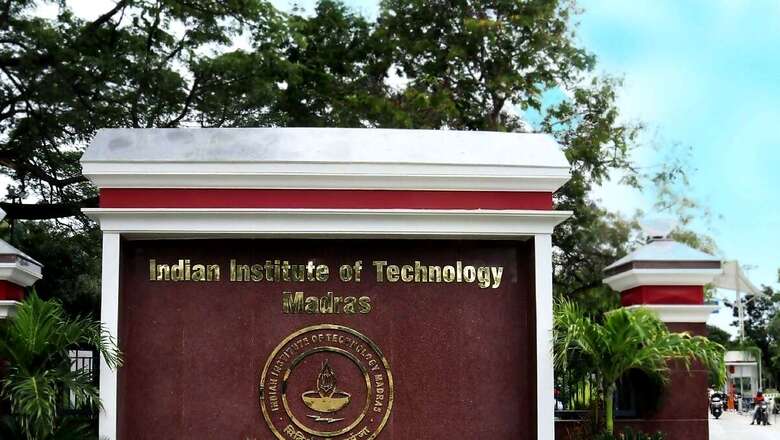
views
The suicides at IIT Madras and IIT Bombay made headlines recently, though proportionately, more students die of self-harm across schools and colleges in India than in these halls of fame. Thirty-three students have died by suicide across the Indian Institutes of Technology (IITs) since 2018. The corresponding figures for the National Institute of Information Technology (NIIT) and the Indian Institutes of Management (IIM) are much lesser, with the IIMs having the least.
The political mayhem and insane chaotic speculations around the causes of suicide have caused agony, fear and a divide among students on the basis of caste. The widely reported investigations and wild allegations flowing to and fro have also vitiated the atmosphere and an uneasy calm prevails in the affected and the non-affected campuses. Intimidating teachers and gherao of the Director inside the campus following a suicide does not help.
Following are the measures one can take to further prevent suicides and promote resilience in the institutes.
Walking, Talking Counselling Centres
All IITs do not have full-fledged counselling centres. The institutes need to have at least one psychologist for 350 students. These centres need to be walking talking centres that reach out to students and not wait for them to be referred by the faculty, other students, parents or themselves. The counselling centres need to engage with the parents of the students both online and offline.
Meetings along with the wards could prove to be helpful. Psychologists need to actively penetrate the classrooms and hostels and conduct activities on mental health such as resilience building, interpersonal skills, study skills, confidence building, sleep hygiene, saying no to drugs, tackling failures, mindfulness, emotional hygiene, managing parents and others. When activities leading to good health will be transacted, ill health will lose its shame and present itself to the experts for early treatment. These centres need to be far away from the geographical premises of the Director.
Funds for them can be made easily available from the tonnes of money the alumni pour in and the hundreds of crores the government gives for infrastructure and research. Suicide prevention needs to be a narrative that is woven into the ethos of the campus, including families of the teachers, non-teaching staff and others. The action plan needs to have the entire community be the participants and the receivers of the emotional health package. The passion towards ensuring good mental health should be similar to the festivals the institutes host such as ‘Mood Indigo’, ‘Tech Fest’ and others.
Many professors shudder at the word ‘suicide’, ‘mental health’ or ‘psychiatrist’ and constantly ask me to use softer words that convey the same meaning due to the shame and fear they associate with these terminologies. Such attitude needs to be shattered and we need to hold the issue by the jugular. There has been a general increase of 10 percent in suicides in 2020 and a further 7 percent increase in 2021. Student suicide increased by 4.5 percent in 2021. Maharashtra had the highest number of student deaths by suicide in 2021 with 1834, followed by Madhya Pradesh with 1308, and Tamil Nadu with 1,246 deaths.
Mentors, Mental Health Camps & Mental Health Soldiers
The visibility of mental health work, both in building resilient communities and preventing suicides needs to be high. Shame and stigma will be shattered if the faculty members walk into the centres with their family members for mental health check-ups and seek help, if necessary. Imagine a scenario where the Director and the senior deans access the services in the full glare of the world, just like politicians and community leaders who took Covid vaccine before anyone else, to boost social confidence.
If faculty members talk openly about their mental illness and share the details of their own treatment, the stigma will break into a billion pieces. The students and the community at large will surely seek help without shame. More than 20 years ago, the Late Gopalakrishnan, a social worker, and I conducted the first mental health camps at railway stations at Churchgate, Bandra, Borivali and others. The response was humongous. The public at large was willing to talk and the mental health professionals were sceptical in asking bold questions. In my experience, for the last 20 years, I’ve been seeing participants in my workshops at the Mumbai University UGC programmes and across the country raising their hands openly and admitting to past attempts of self-harm and thoughts about the same in the present when asked in class.
There is a lot of helplessness around and students are willing to talk. Public Mental Health Camps on campuses, frequently, are a must that have skits, plays, videos and other means to promote mental health and screening of students for stress, anxiety, and depression. Long ago, a Dean of one of the IITs, when approached for a suicide prevention workshop, rattled off figures that the percentage of suicide was very small and so, refused such an activity. Such teachers forget that life is not about statistics alone and for the family who lost a ward, it is a 100 percent loss. In many IITs, faculty members are appointed as mentors to a bunch of students, which is a great idea.
Alongside continuous training, brushing up on skills is necessary. Periodic meetings, where the mentors can share their experiences, will be phenomenal learning which can then become institutional memory for the future. Both teachers and the students need to be trained as mental health soldiers who have their eyes and ears open to pick up high-risk students for early intervention. Their task is also to facilitate early access to mental health services for those who need it the most.
Informal chats with students, going for a walk with them, and fireside conversations help build bonds and improve community health. The Ministry of Health and Family Welfare (MoHFW) has released a 38-page manual on National Suicide Prevention Strategy that can be used here too.
Politics, Police Investigations and Psychological Autopsy
Invariably, suicides in India lead to political football and turmoil many a time. The death of Rohith Vemula, Payal Tadvi, Ram Kishan Grewal, Sushant Singh Rajput, a schoolgirl in Tamil Nadu and others have led to political parties playing with the dead souls for one-upmanship and scoring political brownie points. In Tamil Nadu, after the girl’s demise following self-harm, there were widespread rumours that led to riots. This would not have occurred if any of them would have died of dengue, malaria, road accident or heart attack. The same is true for the IIT suicides.
The media during the demise of Sushant Singh Rajput played havoc, perpetuating false theories, spreading myths and canards thereby causing agony to many who were on the edge mentally. A scientific tool to assess and evaluate a successful suicide is the psychological autopsy which helps evaluate the processes by interviewing friends and teachers, scanning social media accounts and medical records, conducting family interviews and talking to significant others. There is significant research on this across the world and in India too, and this method is used by various institutions including the Armed Forces. In the case of the IIT-B and IIT-M suicides, this method needs to be followed to ascertain the truth and separate facts from fake news. Science and not speculation will help understand the truth reasonably and prevent agony and pain to everyone around.
I’ve written to the high court asking for psychological autopsies in such cases in the past but failed to evoke a positive response. The belief that such an investigation may not unearth sociological pressures and emotional distress perpetuated by others, is false. The autopsy is an inclusive process that looks at all the variables. Suicide is a complex process and to believe that a one-off mild brawl can lead to serious self-harm is largely far-fetched. Though I agree that the minds of the young are more brittle than that of the youth of yesteryears, I see many children hiding the details of their past treatments of mental illness from the institute.
The IITs should facilitate an environment where the young can openly share their stress, distress and illness about the present or their past. Assessment at admission and frequent screenings, informal and formal, is a must, guided by a ‘well-crafted mental health policy’ that is inclusive.
Red Flags, Reservations & Raising Robust Communities
When a student looks sombre, sad, evades classes or labs, appears lazy, suffers from sleep issues, smokes cannabis or other addictive substances alongside, is irritable, angry, feels hopeless, worthless, quits WhatsApp groups, talks less to parents, avoids classmates, has recurrent bad grades, talks about running away and dying, he/she should be immediately rushed to a mental health centre. The issue of reservations in admissions and the irresponsible narratives related to the demise of young souls is causing a subtle poisonous divide among students in IITs. In my workshops with fresh MBBS students, we discuss these issues threadbare to harmonise various thoughts, feelings and perspectives, thereby helping promote robust healthy communities. This would mean that skilled facilitators need to build that oneness among the students on each campus. Unlike in the past, many students come from small towns, marginalised communities and are not proficient in the English language.
Such boys and girls need a lot of hand-holding by the teachers and need to be empowered. IITs are not citadels of teaching, engineering alone, but also of nation building as well. Gadgets have changed the lifestyle of students in the recent past. This has caused isolation among many as they live behind closed doors. Activities that bring students together frequently via sports, outdoor activities and festivals will help enhance mood.
‘Sabka Saath, Sabka Vikas’ can only happen if social engineering amalgamates with engineering in IITs. The former is more important than the latter, to building healthy, wholesome, confident, compassionate and skilled professionals in the institutes. This is the challenge of our times! We all need to dare to break the invisible Frankenstein barriers and unite souls. Is this a far-fetched dream? No! This is possible.
Dr Harish Shetty is a psychiatrist at Dr L.H. Hiranandani Hospital. The views expressed in this article are those of the author and do not represent the stand of this publication.
Read all the Latest Opinions here

















Comments
0 comment